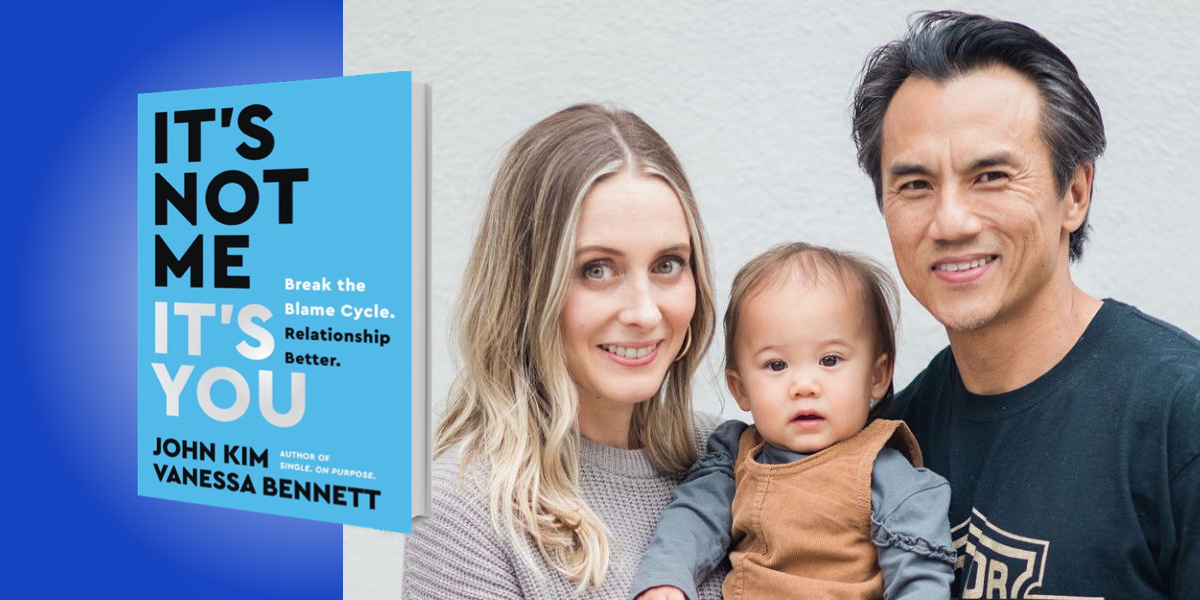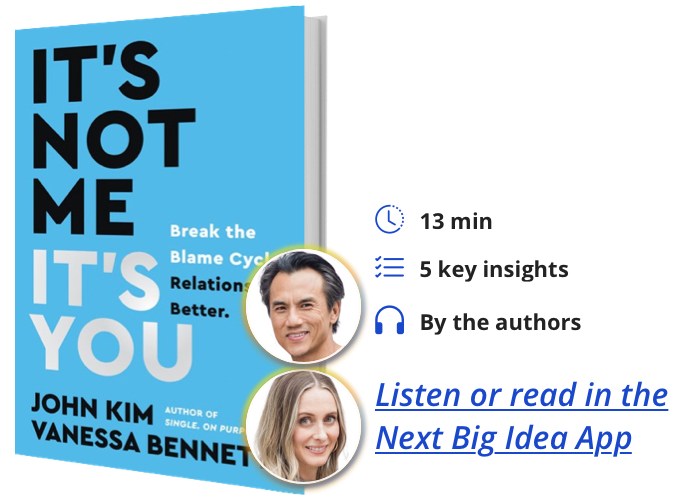John Kim and Vanessa Bennett are licensed marriage and family therapists. John Kim was a pioneer in the online life coaching movement and has a devoted following of fans who appreciate him as an unconventional therapist. Vanessa Bennett is a holistic psychotherapist and codependency expert. She co-hosts the Cheaper Than Therapy Podcast and leads retreats and workshops.
Below, John and Vanessa share 5 key insights from their new book, It’s Not Me, It’s You: Break the Blame Cycle. Relationship Better. Listen to the audio version—read by John and Vanessa themselves—in the Next Big Idea App.
1. Happily ever after is BS.
We’ve been programmed by Disney and romantic comedies to believe that once you find “the one,” then you have reached the place from which things will finally be easy—which is completely untrue. In all of these movies, they classically end with the wedding. No one sees the hard work that it takes to keep relationships thriving and happy.
For example, you can watch the kiss that Cinderella and Prince Charming share at their wedding, but never see that moment five years into the marriage when Cinderella is screaming at Prince Charming to pick up his socks for the fifth time that week.
There is no happily ever after. There is only rebuilding, evolving, and working on relationships. Finding someone that you want to invest in doesn’t mean that the work is over.
The problem with this concept of “the one” is that it’s an escape hatch. It’s an eject button for when things get hard. It’s a thing to hide behind when someone doesn’t want to put hard work or investment into a relationship. The one is the one standing in front of you that you’re choosing to love right now.
2. Fight without fighting.
It’s not about the frequency of fighting, but about how a couple fights. If we are never taught how to fight in a healthy way when we’re growing up, then as adults we get into relationships and become walking reactions. We steamroll people and don’t fight fairly.
“When someone says we never fight it means that people are hiding.”
Most of us graduated high school knowing geometry, even though we don’t use it on a daily basis. Whether you steamroll or are conflict avoidant, either way, these are unhealthy patterns that need to be broken in order to have healthy relationships.
When we hear clients say “We never fight,” that’s actually a red flag. Fighting is normal. Conflict is okay and natural. When someone says we never fight it means that people are hiding. The relationship goal isn’t not fighting, but fighting in a healthy way. It’s about creating a safe space for being heard and understood. This produces relationship glue by stopping blame cycles and getting people to take ownership.
3. Try understanding before trying to be understood.
This concept was a game changer for me (Vanessa) personally. Before meeting John, I was conflict avoidant. I would shut down, unable to tolerate or handle the intense feelings that would come up during conflict, so I avoided conflict at all costs. This idea of trying to understand before being understood helps me stay present in the current moment. It’s like a mantra of mine when I am sitting across from my partner. I remember that curiosity and judgment cannot live in the same space. Being curious and attempting to understand where your partner is coming from shuts down the area of your brain that’s judging and coming at them—instead of with them.
I’ve been trying to be understood without making an effort to understand for most of my life. I would go into relationships not willing to let go of the tug-of-war rope. I would go into arguments wanting to win, wanting to be right. Once I started trying to understand my partner before trying to be understood, I was able to put the shield down and be more empathetic. When you do this, then you get the same from your partner and set the stage for honest conversation. It neutralizes the space, making it safe.
4. Underfunctioning versus overfunctioning.
Underfunctioning and overfunctioning are ways that we respond to anxiety. An underfunctioner might respond to anxiety by withdrawing. They have a deep belief that they are incapable of doing things right, so they don’t try. An overfunctioner experiencing anxiety will do the opposite—they overdo, plan, put things in boxes, organize. This often comes across as being a controlling personality, trying to manipulate outcomes and others’ emotions. Often, the overfunctioner really has to own their part in breaking the cycle, step back, and allow the underfunctioner to step forward into their power.
“A parental dynamic in a romantic relationship kills desire and romance.”
The dance most people tend to find in partnership is one where we have attracted the opposite personality structure to our own. The underfunctioner is attracted to the overfunctioner and the overfunctioner is attracted to the underfunctioner. It’s a good match because you allow the other person to fulfill your needs.
This underfunctioner/overfunctioner pairing usually shows up as a parental dynamic. Once this cycle of behavior between the two sinks its teeth in, a parental dynamic emerges between the couple. Let’s be real—it’s very unsexy, right? Esther Perel talks at length about how we are hardwired to not want to be intimate with our child. So, a parental dynamic in a romantic relationship kills desire and romance.
I (John) went from mouth to nipple in many of my relationships because of under-functioning. I started off as her partner and ended up her son. This is a dangerous dynamic for a relationship.
5. Find beauty in contrast.
This is not just about romantic relationships, but any relationship. In the beginning of a relationship, we might have been attracted to the differences that a person embodied. However, these differences start to be sources of irritation or discomfort as time wears on. The response should be to practice finding beauty and allure in the different way that your partner approaches or sees life, rather than let it fester as an irritant.
Without making an effort to find beauty in differences, it’s easy to check those differences as negatives and use them as an easy way out of the relationship. Differences can become labeled as markers that maybe this person is not for me, and results in ambivalent behavior that rocks the relationship. But once a person starts to appreciate, embrace, discover, and find beauty in differences, then they can fully lean into the relationship, be more present, and have more gratitude for their partner.
“Own your part, because healthy dynamics cannot exist through finger-pointing.”
This concept is a daily practice. If you become aware of annoyance toward your partner’s differences (whether out loud or not) practice stopping and paying attention to what’s going on internally. Own your part, because healthy dynamics cannot exist through finger-pointing.
People regularly come into our office and immediately point their finger at their partner and say, Fix this person, they’re broken. But what’s your part? By owning your own portion, you allow a safe space for your partner to do the same. However, you’re not doing the work for the sake of making your partner do the work—you’re doing it because to have any healthy relationship you need to be able to look inward.
As two therapists who work with couples and are ourselves a couple, we want to change the temperature of self-betterment by showing how we approach our own relationship and disclosing that we struggle and are not perfect. Therapists don’t have perfect relationships. We’re here to bring you the concepts that we struggle with, and the tools that we use day to day to work through difficulties together, on the same team.
To listen to the audio version read by authors John Kim and Vanessa Bennett, download the Next Big Idea App today:

































